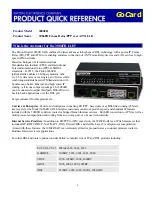
Troubleshooting
July 1998
12-13
T
R
O
U
B
L
E
S
H
O
O
T
This sends a packet to the Network Interface Card once every second. To
abort the ping command, use Ctrl-C or the Delete key. If a message like the
following appears, check the cable; and try it with another transceiver.
No answer from
<printername>
You can ping the printer but cannot print.
The problem is with the
lpr/lpd
setting.
Verify that the
printcap
entries are correct. Each line should begin with a
colon (:) and except for the last line should end with:\. Each line after the Þrst
line should be indented (tabbed). A sample entry is shown in ÒUNIXÓ
Systems.Ó
If there are problems in the printcap entries, the Þles will not print, and you
will get the message Òwarning: no daemon presentÓ when you try to look at
the print queue using the lpq -P <printername> command. The Þle /usr/adm/
lpd-errs will contain error messages explaining why the Þle was not printed.
Check for error messages.
You can only print small Þles.
If large Þles (usually 1 MB or more) fail to print, check to see if the printcap
entry contains a line reading:mx#0. If the line does not exist, you should add
it. You should also check to see if there is enough room in the spool directory
to accommodate large Þles.
You cannot print from a DOS or Windows application.
If you cannot print from the application you are using, redirect the output to a
Þle from the application, and print the Þle from the command line. This will
help you to determine if the application is sending the data properly or if a
problem exists at the application or driver level.
















































